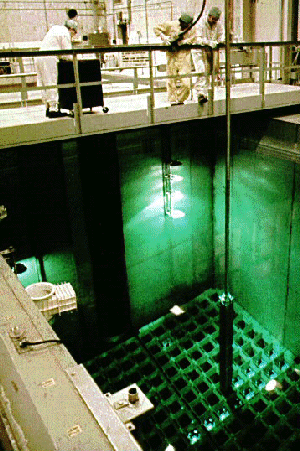- Fuel Assemblies
- Moderator
- Coolant
- Control Rods
- Supporting Structure
- Vessel-either horizontal or vertical
The Nuclear Reactor - How They are Constructed
A nuclear reactor consists of
|
|
Fuel - Each fuel rod of Zircaloy contains stacks of uranium dioxide pellets. Zircaloy (2 or 4) is an alloy of zirconium with low concentrations of tin, iron, chromium, and nickel . Sometimes the fuel may contain boron or gadolinium to aid in the control of the nuclear reaction. In some reactors as the older design Magnox gas cooled reactors, uranium metal may be used as the fuel.
The fuel rods may be individually loaded into the reactor (into tubes located in the reactor) or may be organized into fuel assemblies, as in the case of the BWR fuel assembly shown above, of a square or hexagonal design, 6-10 inches nominal width. In this case, there are about 120 to 900 fuel assemblies in a reactor. Each assembly consists of 50 to 200 fuel rods. Most reactor cores are about 12 to 15 feet high or long, depending on the reactor type. (An update will show photos of the fuel)
 |
This photo shows a fuel assembly (approximately 8-in x 8-in x 14-ft) being moved in the spent fuel storage pool of a nuclear power plant. This fuel assembly has 179 fuel rods. Click to see a sketch illustrating how the fuel pellets make up one of the rods and the fuel rods make up a fuel assembly. |
Moderator - Used to slow down the neutrons to thermal energies. Sometimes the same material is used as a coolant. Typical materials that can be used as moderator include water, heavy water, and graphite. Water is often used because it is plentiful and inexpensive. In general, the better a material is at "moderating" the neutrons, the lower the fuel needs to be enriched. Heavy water is better than water, however, it is also expensive to produce. Graphite also is better than water, however, some of the effects of exposure of graphite materials to radiation are undesirable.
Coolant - Used to remove the heat from the fuel rods directly if the moderator and coolant are the same material. In cases where a separate moderator is used, coolant tubes are routed through the moderator, removing heat from the moderator directly and fuel rods directly or indirectly. Water is often used as a coolant. However, sometimes heavy water, liquid metals (sodium, potassium), or even gases (carbon dioxide) may be used. These different coolants are discussed in the Reactor Coolants section.
Control Rods - Used to regulate the distribution of power in the reactor while the reactor in operating. The most important function is to insert to shutdown or stop the nuclear fission process when required. An automatic control system, or the operator, can initiate the shutdown. In some reactors, all rods (29 to 100+, depending on reactor size) may insert in as short a time as 2 seconds. The control rods are made of materials that quickly stop the nuclear reaction by absorbing the neutrons (i.e. the materials divert the neutrons from being absorbed or causing fissions in the fuel. Materials used include boron carbide, silver, indium, cadmium, and hafnium.
Supporting Structure - Used to keep the fuel rigid either horizontally or vertically, depending on the specific design. Also is used to direct a uniform, or optimum, flow distribution through the reactor.
Vessel - Used to hold the fuel, moderator, coolant, and supporting structure. Normally, these are able to sustain high pressures. Thickness of the vessel depends on the pressure to vessel is subjected to.
Copyright © 1996-2006. The Virtual Nuclear Tourist. All rights reserved. Revised: December 20, 2005.